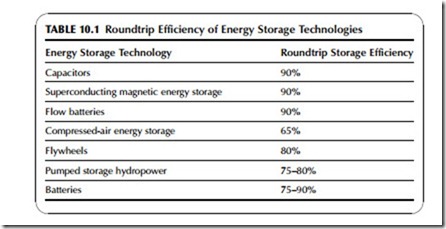TYPES OF ENERGY STORAGE
Electricity is an ephemeral form of energy that normally has to be used as soon as it has been generated. This is why the role of system operators and their electricity dispatching systems are important; they have to balance the demand for electricity with its supply. If one fails to match the other, problems occur: sys- tem voltages rise or fall and grid frequency may change and cause problems across the grid. It would seem obvious, given this situation, that some reservoir of saved electricity would be a major boon to grid operation. Yet storing electricity has proved difficult to master.
Storing electricity in its dynamic form, amps and volts, is almost impossible. The nearest one can get is a superconducting magnetic energy storage ring that will store a circulating DC current indefinitely provided it is kept cold. A capacitor storage system stores electricity in the form of static electric charge. All other types of energy storage convert the electricity into another form of energy. This means that the energy must then be converted back into electricity when it is needed.
A rechargeable battery may appear to store electricity but in fact it stores the energy in chemical form. A pumped storage hydropower plant stores potential energy, a flywheel stores kinetic energy, and a compressed-air energy storage plant stores energy in the form of compressed air, another type of potential energy. Alternatively, one might use electrolysis to turn electricity into hydro- gen, yet another chemical transformation of the energy. This can then be burned in a thermal power plant or used in a fuel cell to turn it back into electricity.
The storage systems based on these processes are all viable ways of storing electricity and many of them are commercially available. Each has different characteristics, such as response time and storage efficiency, that helps differentiate the technologies and define their applications.
Some of these systems can deliver power extremely rapidly. A capacitor can provide power in 5 ms, as can a superconducting energy storage system. Fly- wheels are very fast too, and batteries should respond in tens of milliseconds. A compressed-air energy storage plant probably takes 2–3 minutes to provide full power. Response times of pumped storage hydropower plants can vary between 10 seconds and 15 minutes. This technology is generally suitable for peak power delivery but less suited to fast-response grid support.
The length of time the energy must be stored will also affect the technology choice. For very long-term storage of days or weeks, a mechanical storage sys- tem is best, and pumped storage hydropower is the most effective provided water loss is managed carefully. Batteries are also capable of holding their charge for extended periods. Energy loss in other systems will make them less practical for long-term storage. For daily cycling of energy, both pumped storage and compressed-air energy storage are suitable, while batteries can be used to store energy for periods of hours. Capacitors, flywheels, and superconducting magnetic energy storage are generally suited to short-term energy storage, though flywheels can be used for more extended energy storage too.
Another important consideration is the efficiency of the energy conversion process. An energy storage system utilizes two complementary processes: storing the electricity and then retrieving it. Each will involve some loss. The round- trip efficiency is the percentage of the electricity sent for storage that actually reappears as electricity again. Typical practical figures for different types of systems are shown in Table 10.1.
Electronic storage systems such as capacitors can be very efficient, as can batteries. However, the efficiencies of both will fall with time due to energy leakage. Flow batteries, where the chemical reactants are separated, perform better in this respect and will maintain their roundtrip efficiency better over time. Mechanical storage systems, such as flywheels, compressed-air energy storage, and pumped storage hydropower, are relatively less efficient. However, the latter two, in particular, can store their energy for long periods if necessary without significant loss.
All these factors must be taken into consideration when considering the most
suitable energy storage technology for a given application. For large-scale util- ity energy storage there are three possible technologies to choose among: pumped storage hydropower, compressed-air energy storage, and, at the low end of the capacity range, large batteries. Batteries can also be used for small- to medium-size distributed energy storage facilities,2 along with flywheels and capacitor storage systems. Meanwhile, fast-acting, small superconducting mag- netic energy storage units are being used to aid grid stability. Superconducting facilities have been considered in the past for large-scale energy storage too, but they appear to be prodigiously expensive based on the technology available today.
